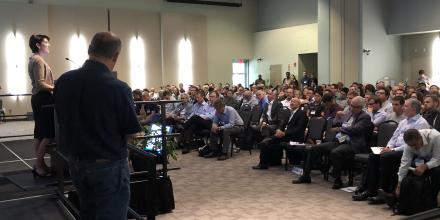Daily summaries from the subseasonal to decadal conference

Day 1: Over 300 scientists gather to discuss subseasonal to decadal weather and climate predictions
Boulder, CO – Walter Orr, the first president of the University Corporation for Atmospheric Research (UCAR) and the founder of the National Center for Atmospheric Research (NCAR), was known for saying science in support of society, remarked Tony Busalacchi, the current president of UCAR. Busalacchi continued by saying that the subseasonal to seasonal (S2S) and seasonal to decadal (S2D) timescales are poised and ripe areas of research for the community to address the needs of society. This conference is aiming to do just that. Convening over 300 researchers from around the world, the conference will be used as a platform to discuss the latest science and exchange ideas to make advances to more seamless and skillful subseasonal to decadal predictions, which are useful to decision makers and stakeholders.
Day 2: A look at modeling and forecast challenges and advancements
For the second day of meetings, participants learned about modeling issues, ensemble predictions, and forecast information available from the subseasonal to decadal timescales. The concurrent sessions continued for both the S2S and S2D topics; below are some highlights.
Day 3: Using subseasonal to decadal predictions in decision making
Marking the halfway point in the conference, the concurrent S2S and S2D themes covered forecasts for decision making, S2S predictability arising from stratosphere processes and variability, and innovation verification methods, observations, and metrics for hindcasts and real-time forecasts in the S2D timescale. Below are some highlights from the meeting.
Day 4: Frontiers in weather and climate research and needs of stakeholders
The fourth day of the S2S and S2D conferences showcased a variety of topics. Before joining back together for a joint plenary session, the S2S theme focused on ocean and land initialization and processes, while the S2D participants wrapped up their conference by discussing frontiers in Earth system predictions. Once the two groups reunited, they approached topics on model initialization, initialization shock, and errors; research to operations; and timescale interactions. Below are some highlights from the day.
Day 5: Future directions for subseasonal to decadal prediction research
After a week of invigorating discussions and a wealth of information presented, conference attendees listened to a few final talks on the interactions of timescales from subseasonal to decadal, highlights from throughout the week, and final remarks on where there is convergence, what questions remain unanswered, and ideas for future research directions. The energy from the week was evident as attendees cued up at the microphones to share their final thoughts with the meeting organizers. Below are the highlights from the final day.
